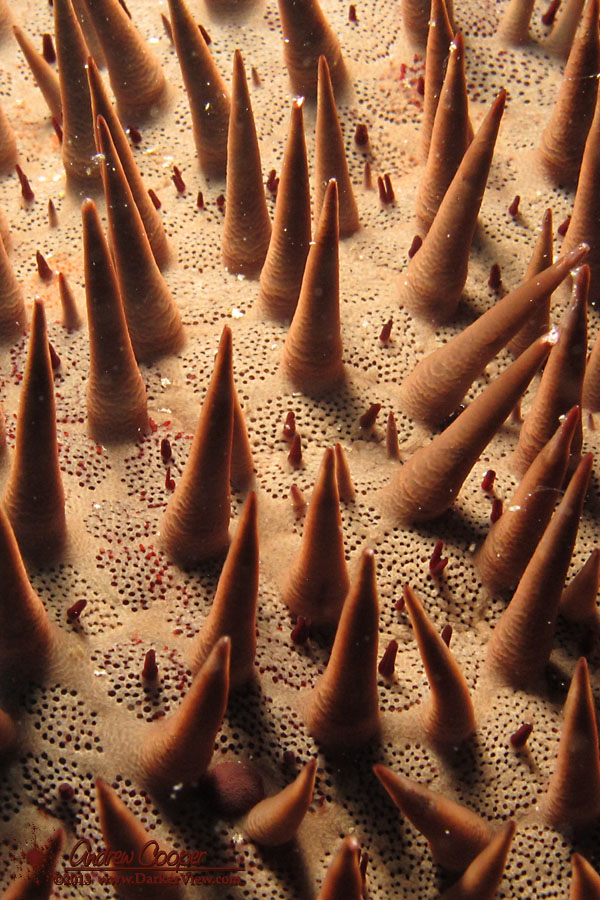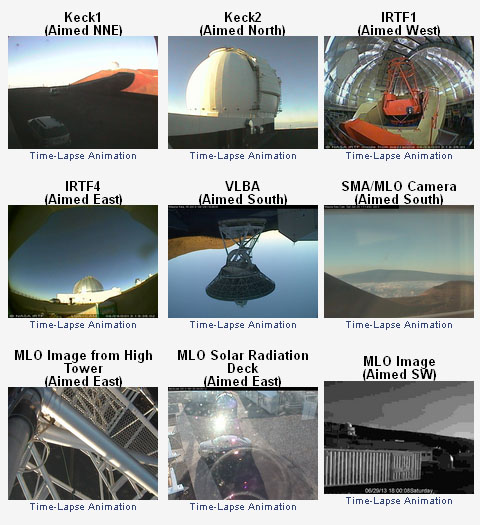I have taken closeups of the top ot the crown-of-thorns before, the view produces a very alien landscape. This time I positioned the light behind the spines for a different effect…

When you want to see the stars, find someplace dark
There are numerous guides to the reef life found around the Hawaiian Islands. Most are superficial, suitable for the casual tourist snorkeler at best. Short of delving into the professional level publications there are two sources I use all the time. The books by Hoover, one on fish and the other for the invertebrates, are my first stop when attempting to identify an animal. These well thumbed references are usually found on my desk beside the computer.

What about an app to do that?
To my pleasant surprise I have found that there is indeed an app. Combining information from John Hoover, Keoki Stender’s excellent photography, plus information from a few other contributors, you can now download everything to your phone for easy reference, even without a data connection.
Actually there are several apps in the series. As with Hoover’s books, fish and invertebrates are handled separately. You can get the phone version or the iPad oriented HS version.
This snorkelers guide to the most common invertebrates and other commonly seen water inhabitants in Hawai’i includes 374 gorgeous photos together with extensive notes for each. All content is by an experts in the field: Keoki and Yuko Stender, and snorkeling guidebook authors, Judy and Mel Malinowski. As a bonus, links to underwater videos by Keller Laros, Rob Whitton, Mel Malinowski and others are provided. – Description of Reef Critters Hawai’i
The apps are well organized and quick to use. As with any book, it helps to be able to recognize at least the family of fish or critter, this helps in navigating to the correct section. Scrolling though a list of species, each with a thumbnail image, allows quick choice of possible identifications.
It is unlikely that the apps will replace my use of the books… The listings are not as complete as the books or websites, many of the less common species are missing. There is generally only one photo per species, neglecting some color phases and juvenile stages. Still, a quick ID reference in the phone is quite convenient. There are a number of videos which I find fairly useless, I would gladly trade the memory requirements for a more complete species listing.
I have no trouble with the $4.99 cost of the apps, I consider it a contribution to the folks who have put together the great references I have used for many years of diving Hawaiian reefs.
I did not see them coming. Sweeping in from above and behind I saw them come over the top. With a kick upwards I was in the school, surrounded by beautiful silver fish. A large school of Heller’s barracuda!
These fish feed at night, spending the day hanging out in large schools over the reef. Even resting they move with graceful speed. I attempt to stay in the school for a while, shooting as I go. I am soon out of breath, sucking air from the tank, worth the effort for such a sight!

So I check the Mauna Kea webcams. The VLBA antenna? Aimed South?

An interesting bit of news passed along, HELCO was planning a power outage at 8pm. I expect my reaction to this information was a little different than most… This is great! With a school star party scheduled at Kohala Elementary, the news that the entire town would be dark for the star party was a pleasant surprise.

I stopped to get dinner in Hawi on the way. Surprisingly the Bamboo Restaurant was open early, they normally do not open until 6pm. I find out that the whole town was bracing for the power cut at 8pm, with events and opening times moved up. Not everyone had gotten the notice, I was the only diner in the restaurant. A pleasant meal chatting with the staff and a good burger were just what I needed, food and a brief rest to prepare for the evening.
Mercury will exit the evening sky this week. Currently about 10° above the setting Sun, it will quickly orbit back into the Sun’s glare. It will pass through inferior conjunction on July 9th to reappear in the dawn around July 17th.
I tend to revise my posts… A lot.
This is particularly true for my essays. I will stew on the text for several days, often saving very minor revisions. As a result there may be 20-30 revisions in the database. I also tend to find a few errors during proofreading that require another save or three. All this editing does add a bit of a clutter.
I do like the WordPress revision feature, it has saved the day more than once. The ability to recover the text from previous versions is simply invaluable.

WordPress does have some tools for dealing with the revisions. Even if you have to know about some of the behind-the-scenes stuff to make changes to revision handling.
Finding how to do this is done through the usual learning materials… A Google search for something like “WordPress limit revisions” provides all you need to know. The information was out there, but I will repeat it here. If nothing more this post can serve as notes for when I next need to purge the database.
W. M. Keck Observatory press release…
A team of scientists recently confirmed six, and possibly seven, planets orbiting a star system a mere 22 light-years from Earth. More importantly, three of those planets are super-Earths, lying in the Goldilocks Zone where liquid water could exist, making them possible candidates for the presence of life. This is the first system found with a fully-packed habitable zone. The findings will be published in the journal Astronomy & Astrophysics on June 26.
Previous studies of the triple star system called Gliese 667C showed the star hosts three planets with one of them in the habitable zone. Now, a team of astronomers has reexamined the system by re-mining existing European Southern Observatory’s HARPS data and combining it with data collected from the W. M. Keck Observatory and the Magellan Telescope to find evidence for up to seven planets around the star. These planets orbit the third faintest star of a triple star system. The two other suns would look like a pair of very bright stars visible in the daytime and at night they would provide as much illumination as the full Moon.
Continue reading “Scientists Discover System with Three Planets in Habitable Zone”